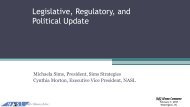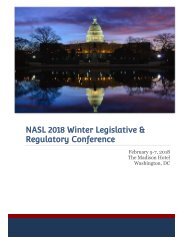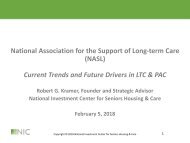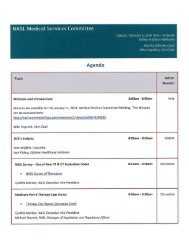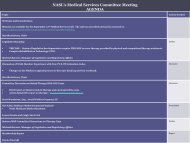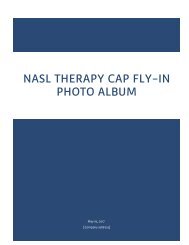You also want an ePaper? Increase the reach of your titles
YUMPU automatically turns print PDFs into web optimized ePapers that Google loves.
<strong>NASL</strong> <strong>IT</strong> <strong>Committee</strong><br />
<strong>NASL</strong> <strong>IT</strong> <strong>Committee</strong> Meeting<br />
Tuesday, February 6, 2018 1:15-3:15pm<br />
Dolley Madison Ballroom<br />
Agenda<br />
I. Welcome & Call to Order<br />
Donna Doneski, <strong>NASL</strong> Director of Policy & Membership<br />
Introduce guests from federal agencies to include:<br />
• Zoe Barber, MPH<br />
Special Assistant, Principal Deputy National Coordinator<br />
Office of the National Coordinator for Health <strong>IT</strong> (ONC)<br />
U.S. Department of Health & Human Services (HHS)<br />
• Liz Palena Hall, RN, MIS, MBA<br />
LTPAC Coordinator, Office of Policy, ONC<br />
• Beth Connor, MS, RN<br />
Nurse Consultant, Center for Clinical Standards & Quality (CCSQ)<br />
Quality Measurement & Value-Based Incentives Group (QMVIG)<br />
Division of Chronic & Post-Acute Care (DCPAC)<br />
Centers for Medicare & Medicaid Services (CMS)<br />
II.<br />
Health <strong>IT</strong> Legislative & Regulatory Update<br />
Donna Doneski<br />
Review of current health <strong>IT</strong> legislation on Net Neutrality & Telehealth, plus implementation of the<br />
IMPACT Act and 21 st Century Cures Act’s health <strong>IT</strong> provisions.<br />
• See chart – Tab A in resource section.<br />
III.<br />
<strong>Committee</strong> Discussion of ONC’s Proposed Trusted Exchange Framework & Common Agreement<br />
(TEFCA), plus Draft US Core Data for Interoperability (USCDI)<br />
Ted Prettyman, Director, Sims Strategies<br />
• <strong>Committee</strong> discussion of proposed TEFCA and USCDI. Refer to Tabs B & C in resource section.
<strong>NASL</strong> <strong>IT</strong> <strong>Committee</strong><br />
Tuesday, February 6, 2018 1:15-3:15pm<br />
Dolley Madison Ballroom<br />
Agenda – continued<br />
IV.<br />
Status of the Data Element Library<br />
Beth Connor, MS, RN<br />
CMS Nurse Consultant<br />
V. New Business<br />
• <strong>NASL</strong> TEFCA Webinar with ONC Principal Deputy National Coordinator Genevieve Morris<br />
Tuesday, February 13 at 2PM EST<br />
• <strong>NASL</strong> <strong>IT</strong> <strong>Committee</strong> Schedule for 2018<br />
Calls are currently scheduled for the third Thursday of the month at 2PM Eastern<br />
• <strong>NASL</strong> & LTPAC at HIMSS18 – March 5 – 9, 2018 in Las Vegas, Nevada<br />
<strong>NASL</strong> is a collaborator of HIMSS18. <strong>NASL</strong> members may attend HIMSS18 in Las Vegas,<br />
March 5– 9 at discounted rate by using <strong>NASL</strong>’s collaborator code.<br />
• 14 th Annual LTPAC Health <strong>IT</strong> Summit<br />
June 25 – 27, 2018 at the Washington Hilton in Washington, DC<br />
<strong>NASL</strong> is helping to plan the Summit with our colleagues from the LTPAC Health <strong>IT</strong> Collaborative.<br />
Please let us know if you are interested in participating as a sponsor, presenter or attendee.<br />
Additional Resources:<br />
• Tab A – Health <strong>IT</strong> Legislative & Regulatory Chart – An overview of health <strong>IT</strong> legislation and<br />
regulation <strong>NASL</strong> is tracking for 2018<br />
• Tab B – <strong>NASL</strong> Summary of TEFCA<br />
• Tab C – Outline of Key Areas of Focus for <strong>NASL</strong> TEFCA & USCDI Discussion
<strong>NASL</strong> <strong>IT</strong> <strong>Committee</strong> Agenda<br />
Tab A<br />
<strong>NASL</strong> Health <strong>IT</strong> Legislative & Regulatory Chart – February 1, 2018<br />
An overview of health <strong>IT</strong> legislation and regulation <strong>NASL</strong> is tracking for 2018<br />
Centers for Medicare & Medicaid Services (CMS)<br />
Policy/ Initiative Description Timeline<br />
IMPACT Act Quality<br />
Measures<br />
Transfer of Health Data & Care<br />
Preferences<br />
October 1, 2018<br />
Medicare Part D<br />
Proposed Rule,<br />
including an update<br />
to the electronic<br />
transaction standard<br />
used by Part D Plans<br />
<strong>NASL</strong> commented on CMS’ Medicare<br />
Part D Proposed Rule, which<br />
includes a provision proposing the<br />
adoption of the NDPDP SCRIPT<br />
Standard Version 2017071, and<br />
retirement of the current NCPDP<br />
SCRIPT Version 10.6, as the official<br />
electronic prescribing standard for<br />
transmitting prescriptions and<br />
prescription-related information using<br />
electronic media for covered Part D<br />
drugs for Part D eligible individuals.<br />
2018<br />
New Medicare<br />
Beneficiary Identifier<br />
(MBI)<br />
The Medicare Access & CHIP<br />
Reauthorization Act (MACRA) of<br />
2015 requires CMS to remove Social<br />
Security Numbers (SSNs) from all<br />
Medicare cards by April 2019. The<br />
new Medicare Beneficiary Identifier<br />
(MBI) will replace the SSN-based<br />
Health Insurance Claim Number<br />
(HICN) used for Medicare<br />
transactions such as billing, eligibility<br />
status, and claim status.<br />
April 2018<br />
CMS will begin sending new<br />
Medicare cards to all<br />
beneficiaries<br />
October 2018<br />
Transition period begins<br />
April 2019<br />
New MBI replaces HICN<br />
Resource: CMS’ New<br />
Medicare Card webpage<br />
Data Element Library<br />
(DEL)<br />
See <strong>NASL</strong> Winter Conference<br />
presentation<br />
May 2018<br />
Expected release of DEL<br />
IQIES & QTSO<br />
See <strong>NASL</strong> Winter Conference<br />
presentation<br />
May 2018<br />
QTSO deadline<br />
IQIES is a 3-year project<br />
<strong>NASL</strong> Health <strong>IT</strong> Legislative & Regulatory Chart<br />
As of February 1, 2018<br />
Page 1 of 3
<strong>NASL</strong> <strong>IT</strong> <strong>Committee</strong> Agenda<br />
Tab A<br />
Office of the National Coordinator for Health Information Technology (ONC)<br />
Policy/ Initiative Description Timeline<br />
TEFCA & USCDI<br />
On January 5, 2018, the ONC<br />
released its proposed Trusted<br />
Exchange Framework & Common<br />
Agreement (TEFCA) and Draft US<br />
Core Data for Interoperability<br />
(USCDI) as required under the 21 st<br />
Century Cures Act.<br />
February 20, 2018<br />
Comments are due<br />
May-June 2018<br />
ONC is expected to issue a<br />
Funding Opportunity<br />
Announcement (FOA) for the<br />
Recognized Coordinating<br />
Entity (RCE)<br />
Late 2018<br />
Final TEFCA to be published<br />
Draft USCDI Version 1 Data Classes<br />
Patient name<br />
Sex (birth sex)<br />
Patient Date of Birth<br />
Preferred Language<br />
Race<br />
Ethnicity<br />
Smoking Status<br />
Laboratory tests<br />
Laboratory values/results<br />
Vital signs<br />
Problems<br />
Medications<br />
Medication Allergies<br />
Health concerns<br />
Care Team members<br />
Assessment and plan of treatment<br />
Immunizations<br />
Procedures<br />
Unique device identifier(s)<br />
Goals<br />
for a patient’s implantable device(s)<br />
Provenance<br />
Clinical Notes<br />
2018 Reference<br />
Edition<br />
Interoperability<br />
Standards Advisory<br />
(ISA)<br />
ONC has posted the latest,<br />
interactive Interoperability Standards<br />
Advisory.<br />
<strong>NASL</strong> Health <strong>IT</strong> Legislative & Regulatory Chart<br />
As of February 1, 2018<br />
Page 2 of 3
<strong>NASL</strong> <strong>IT</strong> <strong>Committee</strong> Agenda<br />
Tab A<br />
Other Federal Agencies<br />
Policy/<br />
Description<br />
Initiative<br />
CDC’s Infectious CDC is engaged in a collaborative<br />
Diseases C-CDA effort to supplement three Health<br />
Project<br />
Level Seven (HL7) Consolidated-<br />
Clinical Document Architecture (C-<br />
CDA) documents:<br />
(1) Discharge Summary<br />
(2) Continuity of Care<br />
(3) Transitions of Care<br />
*As cited in materials for <strong>NASL</strong>’s <strong>IT</strong><br />
<strong>Committee</strong> briefing on November 16,<br />
2017 by Surveillance Branch Chief,<br />
Division of Healthcare Quality<br />
Promotion, Centers for Disease<br />
Control & Prevention (CDC) Daniel<br />
Pollock<br />
Timeline<br />
HL7 Implementation Guide (IG)<br />
Timeline:<br />
• May 28 – Scope Definition<br />
• June 11 – Scope Material<br />
• July 15 – Notice of Intent to<br />
Ballot Deadline, Fall 2018<br />
• July 23 – Design Freeze<br />
• August 19 – Fall 2018 Ballot<br />
Submission Deadline<br />
• September 29 – October 5<br />
Fall 2018 HL7 Working Group<br />
Meeting (WGM)<br />
• December 2018 – Estimated<br />
IG Publication<br />
FCC Repeal of Net<br />
Neutrality Rules<br />
carries implications<br />
for Telehealth<br />
Open Internet<br />
Preservation Act<br />
(H.R.4682)<br />
On December 14, 2017, the Federal<br />
Communications Commission (FCC)<br />
voted to repeal Net Neutrality rules.<br />
FCC’s repeal of the rules means<br />
Internet Service Providers (ISPs)<br />
could speed up or slow down, or<br />
potentially charge more for certain<br />
Internet content. The concern is that<br />
allowing ISPs to control internet<br />
speed based on users, services, sites<br />
visited or content, may negatively<br />
affect seniors or LTPAC providers.<br />
On December 19, 2017,<br />
Congressman Marsha Blackburn (R-<br />
TN) introduced legislation that could<br />
reinstitute some, but not all of the Net<br />
Neutrality rules. The Open Internet<br />
Preservation Act (H.R.4682) has25<br />
cosponsors as of as of January 31,<br />
2018).<br />
On January 16, 2018, New York<br />
Attorney General Eric Schneiderman,<br />
and a coalition of 22 Attorneys<br />
General, filed a multistate lawsuit to<br />
block FCC’s illegal rollback of net<br />
neutrality.<br />
Open Internet Preservation Act<br />
• Amends the Communications<br />
Act of 1934 by prohibiting<br />
broadband internet access<br />
service providers from: (1)<br />
blocking lawful content,<br />
applications, services or nonharmful<br />
devices; and (2)<br />
impairing or degrading lawful<br />
internet traffic on the basis of<br />
internet content, application<br />
or service, or use of a nonharmful<br />
device.<br />
• Such prohibitions do not<br />
prevent providers from<br />
offering specialized services<br />
that are offered over the<br />
same network and may share<br />
network capacity with the<br />
broadband internet access<br />
service.<br />
• Allows broadband internet<br />
access services to be eligible<br />
for federal universal service<br />
support funding.<br />
<strong>NASL</strong> Health <strong>IT</strong> Legislative & Regulatory Chart<br />
As of February 1, 2018<br />
Page 3 of 3
<strong>NASL</strong> <strong>IT</strong> <strong>Committee</strong> Agenda<br />
Tab B<br />
<strong>NASL</strong><br />
Summary & Analysis<br />
DRAFT Trusted Exchange Framework & Common Agreement (TEFCA)<br />
January 20, 2018<br />
Overview<br />
On January 5, 2018, the Office of the National Coordination for Health Information Technology<br />
(ONC) released the Draft Trusted Exchange Framework, which focuses on policies, procedures<br />
and technical standards intended to simplify the exchange of health information and limit costs<br />
associated with the creation of multiple point-to-point interfaces between organizations.<br />
ONC is required under the 21 st Century Cures Act to develop a final Trusted Exchange<br />
Framework & Common Agreement (TEFCA), which will establish a technical and governance<br />
infrastructure to connect disparate health information networks – and by extension to individuals<br />
and providers who use these networks to exchange health information. TEFCA is divided into<br />
two parts. The first part is the Trusted Exchange Framework, which outlines a set of six principles or<br />
“guard rails” for promoting trust across health information networks. These six principles –<br />
standardization, transparency, cooperation & non-discrimination, security & patient safety, access and<br />
data-driven accountability – are described in greater detail below. The second part is the Common<br />
Agreement, which is comprised of a set of minimum terms and conditions that will to help to ensure<br />
that common practices are in place and required of all participating in exchanging electronic health<br />
information. ONC expects to publish the final TEFCA in the Federal Register in late 2018.<br />
TEFCA’s technical infrastructure will support a series of primary networks called Qualified<br />
Health Information Networks (QHINs) that will serve as the main connections for transferring<br />
data across a variety of Health Information Networks (HINs), which facilitate “access, exchange<br />
or the use of electronic health information between or among two or more unaffiliated individuals<br />
or entities.” In addition to the QHINs and HINs, ONC delineates the stakeholders who can use<br />
the Trusted Exchange Framework as federal agencies; public health organizations and<br />
agencies; health information networks; individuals (e.g., patients, caregivers, authorized<br />
representatives and family members); payers; providers (i.e., to include ambulatory, inpatient,<br />
long-term and post-acute care (LTPAC), emergency medical services (EMS), behavioral health<br />
and home and community based services providers); and technology developers (e.g., EHR,<br />
HIE, analytics, laboratory information systems, PHRs, Qualified Clinical Data Registries<br />
(QCDRs), registries, pharmacy systems, mobile technology and other technology).<br />
As part of finalizing the Draft Trusted Exchange Framework, ONC will use an open, competitive<br />
process to select a Recognized Coordinating Entity (RCE). The RCE will work with ONC<br />
through a Cooperative Agreement using the Draft Framework to develop a Common Agreement.<br />
Given ONC’s solicitation for specific feedback regarding the RCE, we believe that ONC may<br />
have an existing entity (or entities) in mind that could be considered for such a Cooperative<br />
Agreement and serve in this oversight role.<br />
<strong>NASL</strong> Summary & Analysis<br />
ONC’s Draft TEFCA<br />
Page 1 of 10
<strong>NASL</strong> <strong>IT</strong> <strong>Committee</strong> Agenda<br />
Tab B<br />
Stakeholder feedback from the Draft Framework will inform the RCE and ONC’s development of<br />
a Common Agreement, which will serve as the fleshed out “terms and conditions” that entities<br />
must agree to in order to become QHINs. Entities can then agree to a single terms and<br />
conditions of the TEFCA to exchange information through the QHINs. A blogpost from ONC<br />
points out that much of the Trusted Exchange Framework is based on existing capabilities in the<br />
health <strong>IT</strong> landscape; however, “some modifications to existing HINs and Qualified HINs may be<br />
needed to meet the objectives identified by Congress in the Cures Act.”<br />
Functionally, the RCE will provide oversight and governance of the Common Agreement and for<br />
Qualified HINs (QHINs), which is defined as a network of organizations working together to<br />
share data and serving a wide range of participants. A Qualified HIN must meet all of the<br />
requirements of a HIN, as well as:<br />
<br />
<br />
<br />
<br />
Be able to locate and transmit ePHI between multiple persons and/or entities<br />
electronically;<br />
Have mechanisms in place to impose Minimum Core Obligations and to audit<br />
Participants’ compliance;<br />
Have controls and utilize a Connectivity Broker service;<br />
Be participant neutral; and<br />
<br />
Have Participants that are actively exchanging the data included in the USCDI in a live<br />
clinical environment.<br />
The QHINs will connect directly to each other, forming the core for nationwide interoperability.<br />
HINs can connect to the QHINs via a “connectivity broker,” which is a service provided by the<br />
QHIN and that delivers all functions for the “permitted purposes” (such as treatment or public<br />
health) to include: master patient index; Record Locator Service; Broadcast and Directed<br />
Queries, and EHI return to an authorized requesting Qualified HIN.<br />
In addition to the Draft Trusted Exchange Framework and TEFCA process and supporting<br />
materials, ONC released the Draft U.S. Core Data for Interoperability (Draft USCDI). The Draft<br />
USCDI is a set of standardized data elements that represent the minimum level of information to<br />
be shared through the TEFCA, with an annual process for proposing, reviewing and adding to<br />
these data elements. The Draft USCDI includes all of the elements of the Common Clinical Data<br />
Set (CCDS) with the addition of clinical notes and provenance.<br />
Comments on the Draft Trusted Exchange Framework and Draft USCDI are due to ONC<br />
by February 20, 2018.<br />
A more in-depth look at various aspects of the Draft Trusted Exchange Framework<br />
follows, along with additional resources and <strong>NASL</strong>’s schedule for review and comment of<br />
this proposed regulation.<br />
<strong>NASL</strong> Summary & Analysis<br />
ONC’s Draft TEFCA<br />
Page 2 of 10
<strong>NASL</strong> <strong>IT</strong> <strong>Committee</strong> Agenda<br />
Tab B<br />
Background & Implementation Timeline<br />
Section 4003 of the 21 st Century Cures Act (Public Law 114-255), which was signed into law on<br />
December 13, 2016, requires ONC to take steps to promote interoperability. Section 4003(b)<br />
directs ONC to, “for the purpose of ensuring full network-to-network exchange of health<br />
information, convene public-private and public-public partnerships to build consensus and<br />
develop or support a trusted exchange framework, including a common agreement among<br />
health information networks nationally. Such convention may occur at a frequency determined<br />
appropriate by the Secretary.” This section also lays out that a Common Agreement may<br />
include:<br />
(I)<br />
(II)<br />
(III)<br />
(IV)<br />
a common method for authenticating trusted health information network participants;<br />
a common set of rules for trusted exchange;<br />
organizational and operational policies to enable the exchange of health information<br />
among networks, including minimum conditions for such exchange to occur; and,<br />
a process for filing and adjudicating noncompliance with the terms of the common<br />
agreement.<br />
Section 4003 also lays out a timeline for implementation. The law directs ONC to<br />
<br />
<br />
<br />
convene stakeholders within six months of enactment;<br />
publish TEFCA one year after convening stakeholders;<br />
develop a directory of participating QHINs within two years of convening stakeholders.<br />
ONC is well on its way to achieving this implementation timeline. On July 24, 2017, ONC held its<br />
first Listening Session with Comment Period. <strong>NASL</strong> submitted comments in response to ONC's<br />
request for comment on August 25, 2017. A second and third listening sessions were held on<br />
September 29 and November 30, 2017, respectively. Moving forward, ONC’s implementation<br />
guideline is as follows:<br />
<br />
<br />
<br />
<br />
<br />
<br />
<br />
January 5, 2018 – Draft Trusted Exchange Framework Released for Public Comment<br />
January 5 – February 20, 2018 – 45-Day Public Comment Period<br />
March 19, 2018 – ONC’s H<strong>IT</strong>AC Trusted Exchange Framework Task Force Presentation<br />
April 18, 2018 – ONC’s H<strong>IT</strong>AC USCDI Task Force Presentation<br />
Mid-2018 – Selection of a Recognized Coordinating Entity (RCE)<br />
December 2018 – H<strong>IT</strong>AC Final Report<br />
Late 2018 – Release of Final TEFCA<br />
<strong>NASL</strong> Summary & Analysis<br />
ONC’s Draft TEFCA<br />
Page 3 of 10
Review & Analysis of ONC’s Draft Trusted Exchange Framework<br />
<strong>NASL</strong> <strong>IT</strong> <strong>Committee</strong> Agenda<br />
Tab B<br />
The ONC’s Draft Trusted Exchange Framework lays out the framework for creating a network<br />
for nationwide interoperability of electronic health information. ONC is focused on ensuring “data<br />
liquidity,” meaning that data can flow freely between entities. Additionally, the openness of the<br />
network is intended to give new technologies (and app developers) access to the data in order<br />
to unlock the potential of health information technology. ONC envisions the products of the Draft<br />
Trusted Exchange Framework will support a “single on-ramp” through which an entity can agree<br />
to work with a single entity of their choice and have access to all electronic health information.<br />
This is done by end users connecting to participants (including Health Information Networks<br />
(HINs), EHR vendors and other organizations) that connect to Qualified Health Information<br />
Networks (QHINs), which in turn handle data requests through Connectivity Brokers,<br />
responsible for responding to queries and returning the requested electronic health information.<br />
Data requests must be for one of six “Permitted Purposes,” including: 1) Public Health; 2)<br />
Individual Access; 3) Benefits Determination; 4) Treatment; 5) Payment and 6) Healthcare<br />
Operations.<br />
NOTE – Participation is voluntary; however, we anticipate that it is possible future<br />
Medicare payment policies could require participating in interoperable exchange.<br />
Also, it is interesting to note that ONC’s supplemental materials for providers<br />
suggest that one way providers can be involved in the Trusted Exchange<br />
Framework is to “require the technology vendors or HINs they contract with be<br />
connected to the network created by the Trusted Exchange Framework.”<br />
TEFCA Goals<br />
ONC lays out five goals for the TEFCA in A User’s Guide to Understanding the Draft Trusted<br />
Exchange Framework. These goals are:<br />
1. Build on and extend existing work done by the industry;<br />
2. Provide a single “on-ramp” to interoperability for all;<br />
3. Be scalable to support the entire nation;<br />
4. Build a competitive market allowing all to compete on data services;<br />
5. Achieve long-term sustainability.<br />
Principles, Process & Operation<br />
The Draft Trusted Exchange Framework itself is divided into two parts. The first part is “Part A –<br />
Principles for Trusted Exchange,” providing an overview of the six key principles guiding the<br />
TEFCA process. The second part is “Part B – Minimum Required Terms and Conditions for<br />
Trusted Exchange,” which provides a framework “terms and conditions” based on these six<br />
<strong>NASL</strong> Summary & Analysis<br />
ONC’s Draft TEFCA<br />
Page 4 of 10
<strong>NASL</strong> <strong>IT</strong> <strong>Committee</strong> Agenda<br />
Tab B<br />
principles that will be used as the basis for developing a more comprehensive Common<br />
Agreement. The agreement will provide for:<br />
<br />
<br />
a common authentication processes of trusted health information network participants;<br />
a common set of rules for trusted exchange; and<br />
<br />
a minimum core set of organizational and operational policies to enable the exchange of<br />
electronic health information among networks.<br />
Through the terms and conditions of the Common Agreement entities accepting those terms<br />
can become Qualified Health Information Networks (QHINs), which will serve as the backbone<br />
of the exchange network.<br />
NOTE – TEFCA is designed to align with requirements under the Health Insurance<br />
Portability & Accountability Act of 1996 (HIPAA). Still, ONC recognizes that not all<br />
users of the TEFCA will be “Covered Entities” or “Business Associates” under<br />
HIPAA, which is the reason TEFCA includes specific terms and conditions to<br />
enable the broader exchange of health information.<br />
Principles<br />
The six principles outlined in the proposed Trusted Exchange Framework are:<br />
1. Standardization – Adhere to industry and federally recognized standards, policies, best<br />
practices and procedures.<br />
2. Transparency – Conduct all exchange openly and transparently.<br />
3. Cooperation & Non-Discrimination – Collaborate with stakeholders across the continuum<br />
of care to exchange electronic health information (EHI), even when a stakeholder may<br />
be a business competitor.<br />
4. Privacy, Security & Patient Safety – Exchange electronic health information (EHI)<br />
securely and in a manner that promotes patient safety and ensures data integrity.<br />
5. Access – Ensure that individuals and their authorized caregivers have easy access to<br />
their electronic health information (EHI).<br />
6. Data-driven Accountability – Exchange multiple records for a cohort of patients at one<br />
time in accordance with applicable law to enable identification and trending of data to<br />
lower the cost of care and improve the health of the population.<br />
Additional information on how these should be implemented appears in the second part of the<br />
TEFCA. The section begins with a lengthy outline of definitions used, followed by sections on<br />
each of the principles, plus sections on Requirements of Qualified HINs, Participant Obligations,<br />
End-User Obligations.<br />
<strong>NASL</strong> Summary & Analysis<br />
ONC’s Draft TEFCA<br />
Page 5 of 10
<strong>NASL</strong> <strong>IT</strong> <strong>Committee</strong> Agenda<br />
Tab B<br />
Process<br />
ONC intends to partner with a private sector entity for implementing the Draft Trusted Exchange<br />
Framework. ONC will select this entity – called a Recognized Coordinating Entity (RCE) – that<br />
will develop the final Common Agreement used in creating the full Trusted Exchange<br />
Framework & Common Agreement (TEFCA). ONC will begin the RCE selection process with a<br />
Funding Opportunity Announcement (FOA), which will award a single, multi-year Cooperative<br />
Agreement to a single RCE sometime in the Spring of 2018. The RCE will serve as the umbrella<br />
organization for governing the TEFCA, including developing the final Common Agreement and<br />
TEFCA products, onboarding QHINs and then governing implementation and ongoing<br />
enactment of the TEFCA. This also includes producing a directory of QHINs.<br />
With the RCE serving as a governance organization, the backbone of the interoperable<br />
exchange network is the QHINs, which are entities that have accepted the Common Agreement<br />
and meet other criteria.<br />
Operation<br />
Once the TEFCA and QHINs are established, QHINs will connect to each other and respond to<br />
inquiries for electronic health information (EHI). Using a Connectivity Broker service, QHINs<br />
respond to supported use cases for the permitted purposes of treatment, payment, healthcare<br />
operations, individual access, benefits determination and public health. The use cases currently<br />
include Broadcast Query (requesting all entities in the QHIN to search for and return<br />
information), Directed Query (seeking information from a single entity where you know<br />
information resides) and Population Level Data (for quality measurement, risk analysis or other<br />
analytics).<br />
In the event of a data breach, for example, the Draft Trusted Exchange Framework proposes<br />
requiring QHINs to notify the RCE within 15 days. Additionally, for security and identity proofing,<br />
the Draft Trusted Exchange Framework requires a minimum of IAL2 and AAL2 Authentication,<br />
with support for FAL2 or FAL3. For patients, providers and other entities can act as a “Trusted<br />
Referee” to confirm a patient’s identity if documents from an Authoritative Source are not<br />
available.<br />
Draft USCDI<br />
Finally, as part of the Draft Trusted Exchange Framework, ONC released the Draft U.S. Core<br />
Data for Interoperability (USCDI), which is designed to establish a minimum set of data classes<br />
that are required to be interoperable nationwide with the ability to expand in an iterative and<br />
predictable way. QHINs will be required to support the latest version of the USCDI, and a new<br />
version will be produced annually (with the first being USCDI v1). The initial USCDI data set<br />
includes the Common Clinical Data Set (CCDS) with the addition of clinical notes and<br />
provenance.<br />
<strong>NASL</strong> Summary & Analysis<br />
ONC’s Draft TEFCA<br />
Page 6 of 10
<strong>NASL</strong> <strong>IT</strong> <strong>Committee</strong> Agenda<br />
Tab B<br />
Draft USCDI Version 1 Data Classes<br />
Patient name<br />
Sex (birth sex)<br />
Patient Date of Birth<br />
Preferred Language<br />
Race<br />
Ethnicity<br />
Smoking Status<br />
Laboratory tests<br />
Laboratory values/results<br />
Vital signs<br />
Problems<br />
Medications<br />
Medication Allergies<br />
Health concerns<br />
Care Team members<br />
Assessment and plan of treatment<br />
Immunizations<br />
Procedures<br />
Unique device identifier(s)<br />
Goals<br />
for a patient’s implantable device(s)<br />
Provenance<br />
Clinical Notes<br />
Beyond USCDI v1, two other categories of data classes will be Candidate Data Classes, which<br />
are being considered for inclusion in future USCDI versions, and Emerging Data Classes, where<br />
stakeholders are working toward developing standardized data classes and setting technical<br />
specifications. Data elements can remain in these classes over multiple years before being<br />
accepted into the USCDI.<br />
ONC – Key Areas of Focus<br />
Here are a few of the specific areas of focus for which ONC is soliciting comment:<br />
Confidential Unclassified Information<br />
Entities interacting with federal agencies will have a responsibility for protecting<br />
Confidential Unclassified Information, but the agencies cannot enter into contracts with<br />
private entities requiring this protection. ONC is soliciting feedback on how protecting<br />
this information can be required.<br />
RCE Criteria<br />
ONC is seeking feedback on the criteria for selecting the RCE. ONC is seeking H<strong>IT</strong>AC<br />
feedback on whether particular eligibility requirements should be considered in<br />
developing the Cooperative Agreement for the RCE. Other criteria to consider include<br />
things such as whether the entity should be a non-profit, have experience convening<br />
stakeholders, be a health <strong>IT</strong> vendor or exchange and what level of neutrality the RCE’s<br />
subsidiaries or business partners should have to the RCE’s work.<br />
Authentication<br />
Trust is key to this framework, and ONC is seeking feedback on how to authenticate<br />
users across the system to ensure data is protected for providers and patients.<br />
Prescription Drug Monitoring Programs<br />
ONC is seeking comment on how the exchange of health information data in the Draft<br />
Trusted Exchange Framework could support Prescription Drug Monitoring Programs<br />
(PDMPs).<br />
<strong>NASL</strong> Summary & Analysis<br />
ONC’s Draft TEFCA<br />
Page 7 of 10
<strong>NASL</strong> <strong>IT</strong> <strong>Committee</strong> Agenda<br />
Tab B<br />
<strong>NASL</strong> – Key Areas of Focus<br />
In addition to ONC’s areas of focus, <strong>NASL</strong> flags the following topics for your consideration:<br />
<br />
<br />
<br />
<br />
<br />
<br />
Fees – The description of Principle 3 – Cooperation & Non-Discrimination – underscores<br />
ONC’s interest in ensuring the free flow of health information, “even when a stakeholder<br />
may be a business competitor.” In webinars and ONC’s presentation to the H<strong>IT</strong> Advisory<br />
<strong>Committee</strong> (H<strong>IT</strong>AC) on January 19, ONC leadership repeatedly point to Congress’ focus<br />
to prevent information blocking. In that same discussion, ONC acknowledged there may<br />
be some new market opportunities around the TEFCA, which is why ONC is seeking<br />
specific feedback on this topic. The Draft Trusted Exchange Framework would allow, but<br />
not require, QHINs to charge fees for “Reasonable Attributable Costs” related to its<br />
services, including developing APIs and the Connectivity Broker, and employing legal<br />
services for agreements. The Draft Trusted Exchange Framework does not specify what<br />
the fees could be, or set a maximum, so long as the fees are uniformly charged to<br />
entities accessing the QHIN. Are there existing norms with respect to fees for accessing<br />
existing health information networks? Are fees absorbed as part of the software<br />
development process or passed onto clients? Are there fee limits that should pertain<br />
specifically to LTPAC, behavioral health or other non-incentivized providers?<br />
RCE (Oversight Entity) Criteria – Also see ONC’s request for comment listed above.<br />
How should the RCE be selected? Should the RCE be a non-profit, a health <strong>IT</strong> vendor or<br />
some other type of organization? Are there concerns regarding existing business<br />
partnerships for an entity seeking to be the RCE?<br />
Data Set – How does the proposed USCDI process for adding new categories of data<br />
interact with industry? Will this process work like the NQF Measures Under<br />
Consideration (MUC) list? How will information be solicited?<br />
How Existing Entities Will Interact – How will the TEFCA relate to, replace or<br />
supplement existing exchange networks (HIEs, CommonWell, Carequality, etc.)? How<br />
will state-specific requirements be addressed?<br />
Business Considerations – During ONC’s presentations to date, several questions<br />
have been raised regarding what services an HIN or QHIN may be able to offer such as<br />
data aggregation. Others have questioned whether implementation of TEFCA will mean<br />
existing business/software contracts will have to be reviewed and/or renegotiated.<br />
Clearly, implementation of a new federal floor for health information exchange will create<br />
both new opportunities and costs. Are there any particular provisions or definitions that<br />
<strong>NASL</strong> should consider in our review and comment on the Draft Trusted Exchange<br />
Framework & Common Agreement?<br />
Certification – ONC has noted that TEFCA is voluntary at this point. How will TEFCA<br />
relate to ONC’s Certification Program moving forward?<br />
<strong>NASL</strong> Summary & Analysis<br />
ONC’s Draft TEFCA<br />
Page 8 of 10
<strong>NASL</strong> <strong>IT</strong> <strong>Committee</strong> Agenda<br />
Tab B<br />
<strong>NASL</strong> TEFCA Review Schedule<br />
As you consider what questions or concerns you have in response to the Draft Trusted<br />
Exchange Framework, including both ONC’s and <strong>NASL</strong>’s areas for focus, consider the following<br />
recommendations to best support <strong>NASL</strong>’s commenting process:<br />
• Please be specific with the section of the Draft Trusted Exchange Framework with which<br />
you have concerns, citing the specific page number, paragraph or section;<br />
• Please share any broad questions or themes where you have concerns, or any places<br />
where clarification is needed;<br />
• Specific recommendations for how concerns could be addressed, or text of the Draft<br />
Trusted Exchange Framework changed, are very helpful.<br />
Here is the schedule for <strong>NASL</strong> <strong>IT</strong> <strong>Committee</strong> review/comment:<br />
• Thursday, January 25 at 2PM EST – Initial discussion of key points by <strong>IT</strong> <strong>Committee</strong><br />
• Tuesday afternoon, February 6 – Presentation on TEFCA and review of <strong>NASL</strong>’s<br />
DRAFT comments during the face-to-face meeting of the <strong>NASL</strong> <strong>IT</strong> <strong>Committee</strong> during<br />
<strong>NASL</strong>’s Winter Conference in Washington, DC<br />
• February 12 or 13 – Possible webinar with ONC staff<br />
• Thursday, February 15 at 2PM EST – <strong>NASL</strong> will send out revised comments after the<br />
Winter Conference for review during our regular <strong>IT</strong> <strong>Committee</strong> meeting time slot on<br />
Thursday, February 15.<br />
• Tuesday, February 20 – Final comments are due to ONC.<br />
Resources<br />
• Draft Trusted Exchange Framework<br />
• Draft U.S. Core Data for Interoperability (USCDI) & Proposed Expansion Process<br />
• A User’s Guide to Understanding the Draft Trusted Exchange Framework<br />
• HHS Press Release on Draft Trusted Exchange Framework<br />
• Health <strong>IT</strong> Buzz Blog Post<br />
• Draft Trusted Exchange Framework Highlights for:<br />
<br />
<br />
<br />
Consumers<br />
Providers<br />
Payers<br />
• H<strong>IT</strong>AC TEFCA Task Forces<br />
ONC’s new Health Information Technology Advisory <strong>Committee</strong> (H<strong>IT</strong>AC) has set up two<br />
task forces, which will make recommendations relevant to TEFCA.<br />
<strong>NASL</strong> Summary & Analysis<br />
ONC’s Draft TEFCA<br />
Page 9 of 10
<strong>NASL</strong> <strong>IT</strong> <strong>Committee</strong> Agenda<br />
Tab B<br />
H<strong>IT</strong>AC’s Trusted Exchange Framework Task Force will develop and advance<br />
recommendations regarding the Minimum Required Terms and Conditions, selection of the<br />
RCE, clarifying eligibility requirements for the Qualified HINs (QHINs), clarifications around<br />
the six permitted purposes and privacy and security standards regarding identity proofing<br />
and authentication.<br />
H<strong>IT</strong>AC’s S. Core Data for Interoperability Task Force will review and provide feedback on<br />
U.S. Core Data for Interoperability (USCDI) structure and process, including data class<br />
priorities, how USCDI would be expanded and any factors regarding the frequency with<br />
which USCDI would be published.<br />
View ONC’s presentation for H<strong>IT</strong>AC on TEFCA from January 19, 2018.<br />
###<br />
<strong>NASL</strong> Summary & Analysis<br />
ONC’s Draft TEFCA<br />
Page 10 of 10
Key Areas of Focus for <strong>NASL</strong> Discussion<br />
<strong>NASL</strong> <strong>IT</strong> <strong>Committee</strong> Agenda<br />
Tab C<br />
ONC’s Proposed Trusted Exchange Framework & Common Agreement (TEFCA)<br />
and Draft US Core Data for Interoperability (USCDI)<br />
ONC – Key Areas of Focus for which ONC is soliciting comment<br />
• Confidential Unclassified Information<br />
Entities interacting with federal agencies will have a responsibility for protecting<br />
Confidential Unclassified Information, but the agencies cannot enter into contracts<br />
with private entities requiring this protection. ONC is soliciting feedback on how<br />
protecting this information can be required.<br />
• RCE Criteria<br />
ONC is seeking feedback on the criteria for selecting the RCE. ONC is seeking<br />
H<strong>IT</strong>AC feedback on whether particular eligibility requirements should be considered<br />
in developing the Cooperative Agreement for the RCE. Other criteria to consider<br />
include things such as whether the entity should be a non-profit, have experience<br />
convening stakeholders, be a health <strong>IT</strong> vendor or exchange and what level of<br />
neutrality the RCE’s subsidiaries or business partners should have to the RCE’s<br />
work.<br />
• Authentication<br />
Trust is key to this framework, and ONC is seeking feedback on how to authenticate<br />
users across the system to ensure data is protected for providers and patients.<br />
• Prescription Drug Monitoring Programs<br />
ONC is seeking comment on how the exchange of health information data in the<br />
Draft Trusted Exchange Framework could support Prescription Drug Monitoring<br />
Programs (PDMPs).<br />
Additional Areas of Focus Identified by <strong>NASL</strong><br />
• Fees – The description of Principle 3 – Cooperation & Non-Discrimination –<br />
underscores ONC’s interest in ensuring the free flow of health information, “even<br />
when a stakeholder may be a business competitor.” In webinars and ONC’s<br />
presentation to the H<strong>IT</strong> Advisory <strong>Committee</strong> (H<strong>IT</strong>AC) on January 19, ONC<br />
leadership repeatedly point to Congress’ focus to prevent information blocking. In<br />
that same discussion, ONC acknowledged there may be some new market<br />
opportunities around the TEFCA, which is why ONC is seeking specific feedback on<br />
this topic. The Draft Trusted Exchange Framework would allow, but not require,<br />
QHINs to charge fees for “Reasonable Attributable Costs” related to its services,<br />
including developing APIs and the Connectivity Broker, and employing legal services<br />
for agreements. The Draft Trusted Exchange Framework does not specify what the
<strong>NASL</strong> <strong>IT</strong> <strong>Committee</strong> Agenda<br />
Tab C<br />
fees could be, or set a maximum, so long as the fees are uniformly charged to<br />
entities accessing the QHIN. Are there existing norms with respect to fees for<br />
accessing existing health information networks? Are fees absorbed as part of the<br />
software development process or passed onto clients? Are there fee limits that<br />
should pertain specifically to LTPAC, behavioral health or other non-incentivized<br />
providers?<br />
• RCE (Oversight Entity) Criteria – Also see ONC’s request for comment listed<br />
above. How should the RCE be selected? Should the RCE be a non-profit, a health<br />
<strong>IT</strong> vendor or some other type of organization? Are there concerns regarding existing<br />
business partnerships for an entity seeking to be the RCE?<br />
• Data Set – How does the proposed USCDI process for adding new categories of<br />
data interact with industry? Will this process work like the NQF Measures Under<br />
Consideration (MUC) list? How will information be solicited?<br />
• How Existing Entities Will Interact – How will the TEFCA relate to, replace or<br />
supplement existing exchange networks (HIEs, CommonWell, Carequality, etc.)?<br />
How will state-specific requirements be addressed?<br />
• Business Considerations – During ONC’s presentations to date, several questions<br />
have been raised regarding what services an HIN or QHIN may be able to offer such<br />
as data aggregation. Others have questioned whether implementation of TEFCA will<br />
mean existing business/software contracts will have to be reviewed and/or<br />
renegotiated. Clearly, implementation of a new federal floor for health information<br />
exchange will create both new opportunities and costs. Are there any particular<br />
provisions or definitions that <strong>NASL</strong> should consider in our review and comment on<br />
the Draft Trusted Exchange Framework & Common Agreement?<br />
• Certification – ONC has noted that TEFCA is voluntary at this point. How will<br />
TEFCA relate to ONC’s Certification Program moving forward?<br />
Draft USCDI Version 1 Data Classes<br />
Patient name<br />
Sex (birth sex)<br />
Patient Date of Birth<br />
Preferred Language<br />
Race<br />
Ethnicity<br />
Smoking Status<br />
Laboratory tests<br />
Laboratory values/results Vital signs<br />
Problems<br />
Medications<br />
Medication Allergies<br />
Health concerns<br />
Care Team members<br />
Assessment and plan of<br />
treatment<br />
Immunizations<br />
Procedures<br />
Unique device identifier(s) Goals<br />
for a patient’s implantable<br />
device(s)<br />
Provenance<br />
Clinical Notes




